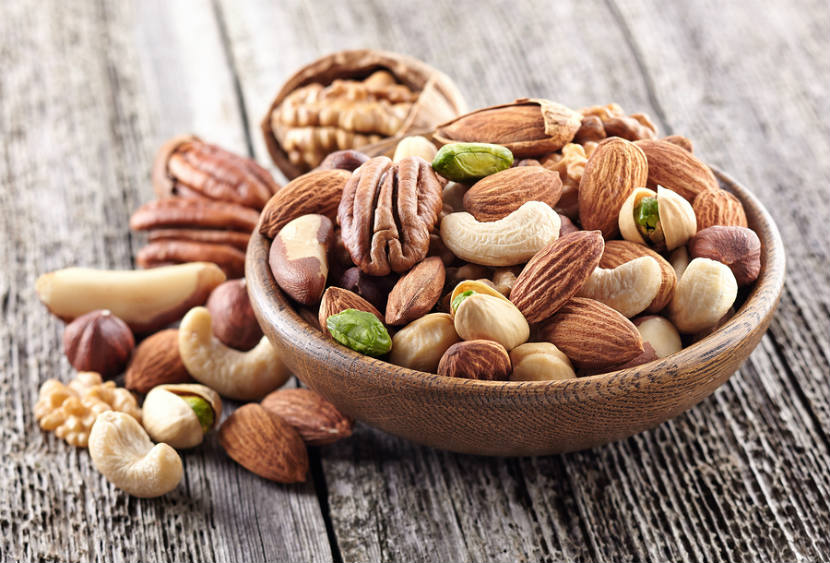
Research shows that eating nuts and seeds has many health benefits. Nuts can help keep your heart healthy and your blood pressure low. They may protect you against some cancers and improve your bowel health. Read on to learn more about using nuts.
For more on the health benefits of nuts read Choose Nuts and Seeds More Often.
Buying nuts
Try to buy nuts from a busy store. That way the stock is often refilled and the nuts don’t go bad. Most nuts should not be stored in bulk bins for more than 1 month because they can go bad quickly. If you can, buy nuts that are still in their shells because they will last longer.
Choose nuts that look fresh. Avoid those that are shriveled, moldy, bruised or give off a bad smell. Nuts that give off an unpleasant odour may be rancid (rotten).
Choose plain unsalted nuts most often. You’ll get the great flavour of nuts without added sugar or sodium.
Storing nuts
The best way to store nuts is in an airtight container in a cool dry place, like the refrigerator. If storing at room temperature, store away from direct heat or light.
You can also freeze nuts. When freezing, use an airtight container or heavy duty freezer bag. If nuts develop an off flavour, bad smell or grow mold, throw them out.
Storage times for nuts (without their shell)
|
Type
|
Pantry
|
Fridge
|
Freezer
|
|
Almonds
|
Keep refrigerated
|
9 months
|
12 months
|
|
Brazils
|
Keep refrigerated
|
Up to 9 months
|
Up to 12 months
|
|
Cashews
|
Keep refrigerated
|
6 months
|
12 months
|
|
Chestnuts
|
Keep refrigerated
|
4-5 days
|
9-12 months
|
|
Macadamia
|
Keep refrigerated
|
6 months
|
9-12 months
|
|
Peanuts
|
Keep refrigerated
|
3 months
|
9-12 months
|
|
Pecans
|
Keep refrigerated
|
9 months
|
2 years
|
|
Pine nuts
|
2-3 months
|
Up to 12 months
|
Up to 12 months
|
|
Pistachios
|
Keep refrigerated
|
3 months
|
12 months
|
|
Walnuts
|
Keep refrigerated
|
6 months
|
12 months
|
Using nuts
Nuts come in a variety of forms. You can find them whole, chopped, flaked, dry roasted, oil roasted, salted, spiced, sugared, ground into flour, pastes and butters, and even made into milk. As a result, there are many ways to add them to your meals. Here are some suggestions to help you enjoy the great taste of nuts and seeds more often.
*Remember, that while nuts are nutritious they do have a lot of fat and calories. Some varieties will also have added sugar and salt. Choose most often plain unsalted nuts. A Canada’s Food Guide serving of nuts is 60 mL (1/4 cup). This is about the amount that can fit into the palm of your hand.
Breakfast:
-
Try almond, cashew or sesame butter (tahini) instead of peanut butter on your toast.
-
Add unsalted chopped nuts to hot or cold cereal, yogurt, smoothies and muffins.
Recipes:
Almond Coconut Granola
Lunch:
-
Add crunch to sandwiches with dry roasted unsalted peanuts or pistachios. (Crush or chop the nuts so they don’t roll out when you take a bite.)
-
Top salads and soups with unsalted walnuts or almonds. (Increase the flavour of nuts by lightly toasting them. Place nuts in a dry frying pan over medium to high heat for 3-5 minutes. Nuts can burn quickly, so watch them carefully).
Recipes:
Bagel Crunch
Carrot and Apple Salad
Dinner:
-
Try to eat one vegetarian dinner each week and use nuts as your protein source.
-
Add unsalted nuts to stir fries, noodles, rice or vegetable dishes.
-
Use ground nuts for coating chicken or fish instead of flour.
Recipes:
Chicken in Mexican Mole
Coconut Cashew Chicken Curry
Snacks:
-
Keep unsalted nuts in your desk drawer, car, or knapsack to grab while on the go. (Don’t forget to mark the bag or container with the date, so you know how long they’ve been there. Remember to follow the storage recommendations for safe and proper handling.
-
Substitute ground nuts (nut meal) for wheat flour in baked goods. This will change the texture, so limit to ¼ cup substitution.
Recipes:
Fibre-Power Biscotti, Dietitians of Canada
Bagel Crunch
You may also be interested in:
Your challenge – choose nuts and seeds more often!
Vegetarianism FAQs
Introduction to protein
Last Update – June 8, 2020